“The NUMBER 1 Playbook every scale-up needs” is
👉The employee handbook 👈
But what is an employee handbook? And what employee handbook essentials will ensure its success.
Remember that book or document that someone gave or emailed you when you joined your team? Or perhaps you were the one giving the document or sending the email?
You know, the one that features all the information that new hires need?
That’s the employee handbook, also sometimes known as an employee manual, staff handbook, or company policy manual.
Not having one will not only leave a gap in your onboarding program, but in your business too!
But why do you need an employee handbook?
Companies with more highly engaged employees show better performance.
Engaged employees, according to a Gallup study;
- Increase productivity by 17%
- Increase customer ratings by 10%
- Increase sales by 20%
- Increase profitability by 21%
- Reduce absenteeism by 41%
Forbes suggests that a disengaged employee costs the company about 34% of their salary😮
Imagine if you could keep team members motivated and engaged from the get-go? That’s just one reason to have an employee handbook.
Having a power employee handbook helps;
- Welcome new employees and share the company values
- Start a good employee experience
- Get team members aligned
- Set expectations
- Share information to frequently asked questions
People often write about compliance but having an employee handbook is not primarily about compliance.
Sure, team members needs to know what the rules of the company are, but it’s more important to focus on getting employees to buy into the culture and way of working.
How to use the employee handbook in onboarding?
An effective onboarding process can significantly impact a new hire’s productivity and job satisfaction.
But that doesn’t just mean SWAG and a company hoodie on the first day. And it also doesn’t mean that giving someone an employee handbook is enough.
Because 60% of employees don’t read the employee handbook when they join.
Why? Because generally, they’re boring.
Previously, we shared 4 examples that we absolutely LOVE, but today we thought we’d share our very own example from Whale 🐳.
If you’re a Whale customer, you’ll be able to find the template on Whale! Otherwise, simply download the presentation template below.
5 Employee handbook essentials
Whilst every company will have their own structure, these are 5 elements that we see as essential for a company manual.
Employee handbook essential no 1: Purpose statement
Purpose is your UBER strategy! It’s your why! It can be linked to “The story” of the company, but it might not be.
Purpose however should direct every single activity in the business, from what gets done (or not), to how to run meetings to how to build product, and more!
Your purpose is why your customers buy from you, why team members are attracted to you and why you get out of bed in the morning so take time to craft it well. It matters!
Employee handbook essential no 2: Values 🏆

In the ‘olden’ days, values used to be stuck up on a wall in big lofty offices but we don’t live in the olden days now, and if you’re going to win the game of entrepreneurship, you’re going to have to walk your talk!
Values should live in the hearts of your team, not on office doors!
If purpose is about why we do what we do, Values are how we achieve that purpose.
In our case that means;
- Make BIG splashes 🌊
- Be humble
- Always honest
- Aim for Frictionless WOW’s!
- Be Humbly Ambitious
You can check out how we live these values here.
Employee handbook essential no 3: Mission 🎯
None of us are here to hold hands and sing kumbaya. We’re all on some kind of mission!
The more you clarify the objectives and name the mission of the company from the beginning, the easier it’ll be to have everyone moving in the same direction.
TOP TIP – Be specific!
Employee handbook essential no 4: The Story 📚
There’s a reason that each business starts, and typically it starts because of one of two reasons; a dream or a problem, or both!
In a way, a business is a modern-day fairytale that always starts with “once upon a time.” In our case, it goes a little something like this;
Of course, this wasn’t the, “and they all lived happily ever after” storybook ending, far from it.
It was just the beginning.
But this was our raizon d’etre / reason for being! Without this beginning, we wouldn’t be here talking to you!
Your business has a story.
You may not think it’s important, but it’s probably the reason that new employees want to work for you. Share the story and get everyone excited about continuing the legacy.
Employee handbook essential no 5: Way of doing things, i.e. culture matters 👏
If purpose is about why a company does what it does and values are how they achieve that purpose, then the way of doing things is a practical guide to living the values. In essence, all of these create a company culture.
94% of entrepreneurs and 88% of job seekers say that a healthy culture at work is vital for success. (TeamStage)
Culture matters!
Here are a couple of items we chose to list in our employee handbook.
We don’t do internal email. We do L10 meetings. We do Slack. We even do memes on Slack – feel free to use as many as you like but we don’t do internal email.
This is to streamline communications and make working at Whale a pleasure, not a pain in the (you know).
If you have an email policy, including it in the employee handbook in a fun could reduce ‘drag’ or reading the document.
Don’t forget to consider HOW you write emails if your business does it a specific way, for example, when talking to customers.
Leave and paid time off
Have you ever read a leave policy that made you fearful you might be arrested on account of wrongdoing? Try to make your leave policy really easy and simple to understand.
We really like this example by Hubspot from their handbook “The Culture Code”

Incidentally, we use a similar approach at Whale . Our team is free to take as much leave as they like.
Why?
Because we believe in supporting individuals in work-life balance, and we hire smart people. We know they’ll hit their objectives, and the more we empower our team members to be accountable, the better for everyone.
Besides, micro-managing is so 1990. ❌
Meetings
Blah, blah, blah…
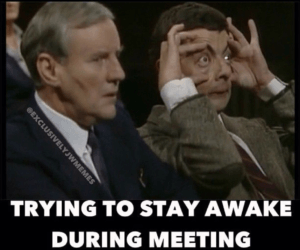
Not many people think about how to run meetings, but meetings and the way your team communicates will dictate the outcome and success of your business.
Ideally you should have a standardised structure of how you run your;
- Daily standup meetings
- Weekly Level 10 meetings
- Monthly all hands meetings
Here’s a sneak peek of our meeting schedule included in our employee handbook.
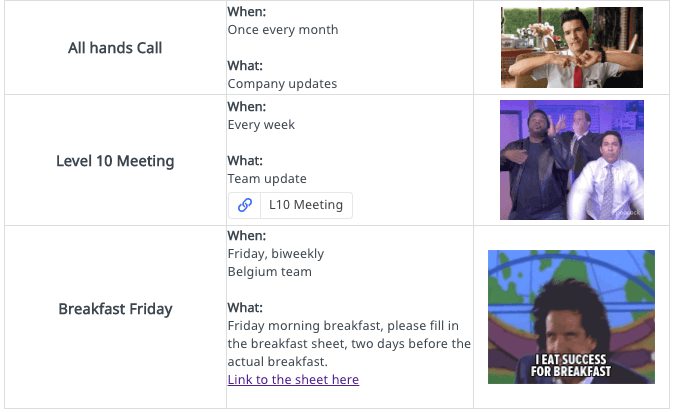
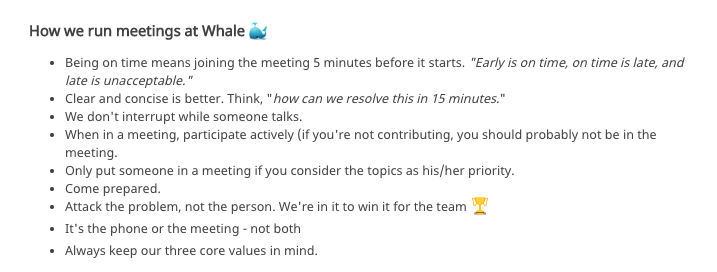
PS – Want to find out how to supercharge your meetings?
Check out this interview with Isaiah Nolte on how to supercharge your meetings.
Learning
How will you approach employee training within your team?
Is learning a part of your culture? Are there specific phrases or terminology that teams need to learn?

If learning is a BIG part of your culture, you’ll want to include an element within the employee handbook on how you approach it.
Metrics
Metrics should be a critical talking point in any business looking to unlock growth. And you may want to consider mentioning them in the handbook.
At Whale, we love metrics. Every team member in their role, decides on the metrics that contribute to company success and to the mission at hand.
This is agreed upon within the first 30 days of joining the team.
Celebrating Success
In a great little piece titled “The Gap versus The Gain” our CEO, Gary, outlined why celebrating success is so important for our team and how it relates back to our values.
Simply put. We celebrate success, no matter how small. And we celebrate each other’s success. This keeps us humbly ambitious.

While celebrating success may not be a useful addition to your business, think about what other items you may wish to include as a unique feature in your handbook.
Other topics you may want to include in your handbook
- Links to all your internally utilized platforms like Whale
- Public holidays
- Ways you connect e.g. we use Slack for messaging etc.
How to create an employee handbook that EVERYONE wants to read?
Include rich media 
We love social media because it’s engaging! Use the principles in creating your playbook.
Go wild with video, GIFs, emojis 

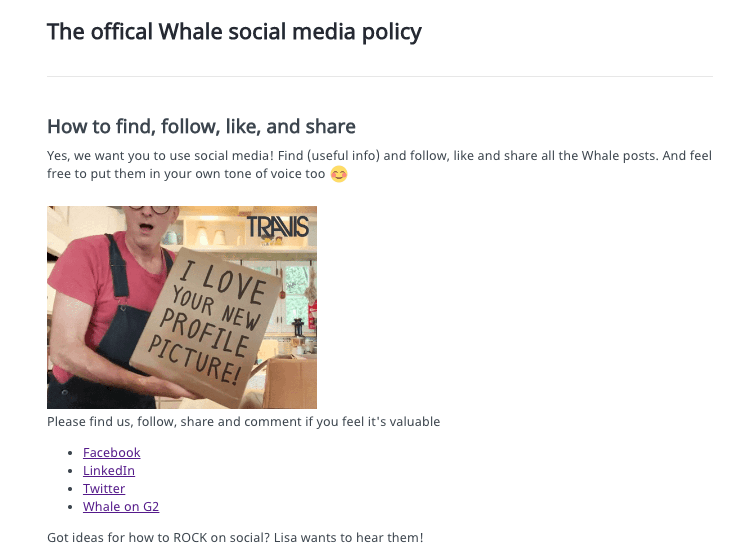
Switch your mindset from rules to entertainment
People watch Netflix because it’s fun, interesting, entertaining, and enjoyable.
So then why make an employee handbook that looks like a book from the legal bar exam?
Make your playbook, this one and others, great to read by writing for enjoyment and not for the legal team.
Does this sound great, but you’re wondering how to apply it in your business? Download our Google Slides Employee handbook template below.
It’s the NUMBER 1 Playbook every scale-up needs!
FAQs about the employee handbook?
How do you write an employee handbook?
Writing or putting together an employee handbook doesn’t have to be difficult.
You can simply get started with a template. Or use a tool like Whale’s AI Assist to get you started.
Don’t forget to include;
- Your company purpose
- Your mission statement
- Vision statement
- Values
- Your company story
- Important policies like paid time off
How do I share our employee handbook with the team?
If writing an employee manual doesn’t have to be complicated, sharing it can be even less so.
The important thing is not to print it and leave it in some drawer!
Have your employee handbook accessible to your team where and when they need it.
Bottom line?
The employee handbook is an essential element of ANY employee onboarding program.
In crafting this ultimate playbook, you hold the blueprint for nurturing a transparent, well-organized workplace where every new hire can thrive. And as a result, so can your business!
Remember, this document is more than a list of guidelines; it’s the cornerstone of your business culture and operational clarity. Invest the time to create the employee handbook essentials mentioned above — your team’s cohesion and your business’s success depend on it.
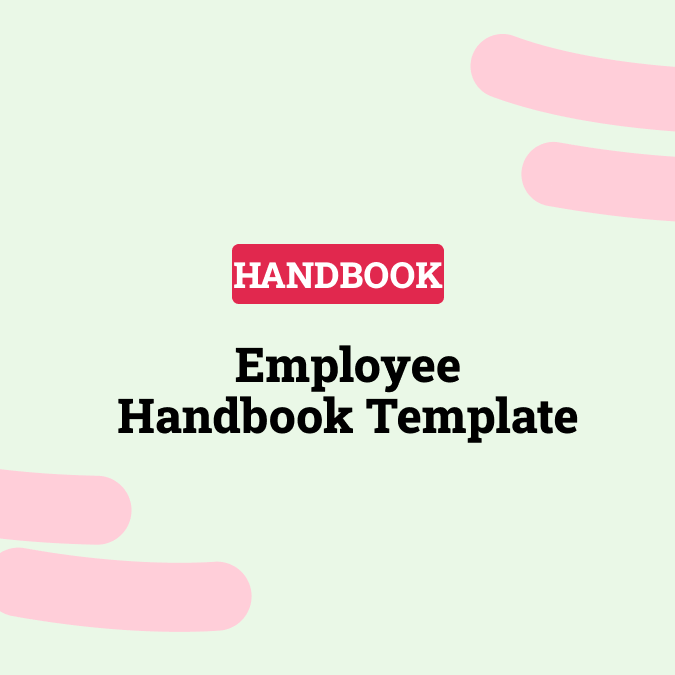
Employee Hanbook template
Creating an employee handbook is hard right? Wrong! This template is designed to make it easy!








